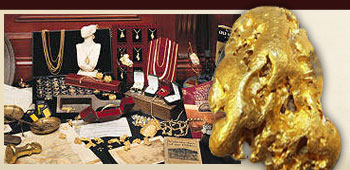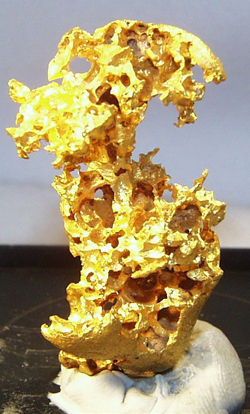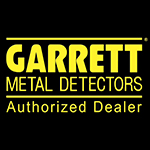
of Gold gifts, Jewellery and Souvenirs
8a Lydiard St North, Ballarat, Victoria, Australia
Telephone/Facsimile: +61 3 5333 4242
Email: mail@thegoldshop.com.au
>> view cart
Sunday 28th Dec, 7:53pm
Megan's First Nugget

How lucky can a person get? When the 150th anniversary of the Eureka stockade was commemorated, the State of Victoria issued special commemorative Miners Rights. Apart from renewing my Miners Right I took each of my 3 children in so they could get one of the special edition licences. My second daughter Megan, then 11 asked if I could take her out with a metal detector and let her search for gold. I thought she might have been kidding, but no, she wanted to go out with her dad and swing a detector and “…dig up things”.
Due to her age and size I charged up a Minelab 18,000 that has been successfully used for years. Even though this detector is a few years old, and doesn’t have the punch of the SD and GP Minelab detectors, the 18,000 is light, the shaft can be shortened a good distance, it has 3 frequency modes and with the standard elliptical head it was a good, common sense detector for her to use on her first day out detecting.
We went out to a spot where I had found gold in the past, and I set her up with the detector shaft set to the right length, then I set it to the highest frequency (so she stood a chance of finding even a tiny nugget). I showed her how to swing the coil evenly, and smoothly, and to overlap each swing so she was getting the best coverage at depth. I didn’t want to go into great detail about coil technology, so I just said, “It goes about this deep (holding my hands apart) but at that depth it only hears a fraction of the coil size beneath the earth’s surface”. Without the detector on we did some practice swings, and I showed her how to twist her wrist at the outside of a swing so the coil stayed close and level to the ground. She was an eager learner.
Then before turning the detector on, I showed her how to put the detector safely on the ground out of the way, but close, and we grabbed a prospector’s pick, a small version of the great picks designed for metal detecting. She said “Come on Dad, I know how to dig a hole”, so we went through the importance of digging a hole with the minimum amount of effort and the maximum effect, while at the same time eliminating the chance of striking and hurting the target. She was then shown how to bring the soil, gravels and clays up into a neat pile, then put the pick out of the road, and swing the detector over and into the hole. All this sounds pretty basic to an experienced prospector, but remember this was Megan’s first day out with a detector.
The next thing we did (without the detector on) was go through the process of halving. I explained to her that if the signal wasn’t in the hole it had to be in the pile of soil and gravel. We did a quick practice run though with swinging the detector in the hole and over the gravel, and she figured out how she should position herself to do this without being in the road of herself and to get her balance right. She was shown how to grab a handful of dirt and gravel and wave it over the top of the coil a couple of times, slightly rotating her hand each time it came back close over the top of the coil. I said if she didn’t hear a target in her hand, to gently place the soil down close to her, but in a neat pile just in case she had to go over it again later. Then she grabbed another handful of soil and gravel, and did like the first time. I told her to pretend she had a signal when she passed her had over the coil. “What then?” she said. I told her to very carefully put half the pile in her one hand into the other hand and hold tight to both, without dropping anything. She then waved her right hand over the coil a few times. I said “OK lets pretend you don’t have a signal, so put that down on your ‘checked already pile’”. She did this and I said, the soil and gravel in her left hand should be carefully divided, so she had some in both hands, and to ‘check’ it again over the coil. “Ok, lets pretend you have a signal in your right hand”. I instructed her to put the unchecked handful of soil and gravel back on the top of the main pile of wash dirt (soil, gravel, clays). We then went through the halving process again, and again until she had only a small amount of wash (short for wash dirt) in her hand, (maybe a thimble full). I then showed her how to carefully cup her hand and go through it.
We had a few problems that she learnt from, like balance and not standing on the lead, and how to position herself so she could do the work without the pick or detector being too far away or in the road. She also listened to good tips on how to preserve her knees and back.
After we went through this trial, I said the next thing you have to do is put your imaginary gold into a film canister and make sure the lid is snapped closed. She sensibly asked what to do if it wasn’t gold, and I told her I normally pick up every target and if it is not gold, I put it into my back left had pocket and at the end of the day I put it into a rubbish bag in my car. Then she said “What if it’s gold and too big to put into a film canister?” I said I usually have my front right pocket empty of other things, and if it is a big nugget, I put it in there.
Then we ran through the process of checking the ‘wash’ and hole for any other targets. I told her it is amazing how many holes produce more than one nugget. “How many have you found in one hole Dad?” I told her I once heard one faint signal and dug it up, and it was only small, but I checked the hole and heard another faint signal and dug that up and it was another small nugget, and I checked the bigger hole and found another small nugget and that when I had finished digging up nuggets I had 79 very small ones from the one original hole, for a total of about an ounce and a half. She said, “Oh, so it is worth checking the holes for more”. We agreed it was.
I then showed her how to fill in her hole and to tamp it back down, spreading leaves and grass back over it.
With the dry runs and basics out of the road, we were ready to turn on the detector. I explained very briefly what all the switches and knobs did, but at that stage most of it went over her head. She asked if I could set it up allowed it to balance itself (called ground balancing). Although this process is relatively automatic with the 18,000 it is still worth giving the auto ground balancing circuits a chance to ‘settle’ and do their job. We then plugged in head phones and I taught her about setting the threshold and what the threshold is supposed to do (act as a reference tone) in the background. We got all that right and she then swung the detector ‘live’. Her technique was pretty good, so we advanced to the ‘different ways a detector talks to you’. I explained that not all nuggets are close to the surface, or lying flat beneath the ground to give a big clear sound. Most of the nuggets are small and sometimes only give off a faint change in the threshold. She listened to the importance of the change in threshold, and how to move around at 90 degrees to the possible target and swing the detector slowly back and forwards, while gently moving the detector closer to her. She got that concept together pretty quickly. I then showed her how to ‘pin point’ the possible location of a target in the ground, by using her eyes and ears.
I gave her a brief run through of what the discrimination mode works like, and how to ‘listen to what the detector says’ to her by the different sounds it makes. I grabbed a small bit of rust from the car and she ‘swung’ over it and heard the different sound. I put the rust back in the car and dropped a $2.00 coin on the ground and let her swing over that at the same height as before, and she noted the signal didn’t ‘break’ like it did on rust. I told her the detector will separate a signal into 2 types of metals when in the discriminate mode, one is for magnetic metals (iron etc) and non magnetic, like gold, coins, lead, bullet cases (“I don’t want to dig up bullets” – but we sorted that concern out). It may be worth noting here that I told her of the prospectors superstition that it is not considered ‘good luck’ to bring gold to a goldfield, and that’s why I was using the $2 coin) and hadn’t brought out a nugget for her to test on.
With the ‘live’ detector she did some more practice with me and I was pretty impressed, and told her so.
So about 30 minutes after we had first started her training, the next thing we did was go over to some old mullock heaps (the dirt thrown out by 19thC miners) and I chose one for her to start on based on its position in the run of diggings, and the mix of dirt, clays and gravels, and I said “Go to it young lady”. I went back to the car and ‘tooled up’ with my detecting gear, which at the time was a Minelab GP Extreme. I had the big detector, the big pick and the years of experience and went off to another section where I could keep a bit of an eye on what Meg was doing. I ended up in my usual ‘zone’ where I become a conscious non thinker. This is the head space I get myself into when I just want to be aware of the ground, and the way the detector is talking to me.
I was working original ground between the shallow holes and I got a signal and begun digging down. I knew the target was down a bit so I got into clearing the dirt, clays and gravels out of the way, and making a decent swing space in the hole for my coil to go into and help pinpoint ‘where’ I should keep digging. Down about 45cm I saw an old time blacksmith made nail, so that came out and into the back pocket, nothing else was to be heard in the hole so I was filling it in when I looked over to see how Meg was going. She was running cautiously towards me with her hands cupped in front of her.
I took off the headphones and unhitched the battery pack and walked over towards her. She said, “Dad, I think I found one!” In her hand was a mass of clay and gravel the size of a cricket ball. I asked if the sound had broken up (indicating iron like I had just found) and she said “No, but it sounds clear”. She gently separated her hands a little and right on top of the pile of clay and wash I saw the glimmer of her first nugget. She was wrapped calling out “Go Girl, Go Girl, Ya Hoo!” She also did a little happy dance.
I gently rubbed the clay off the sides of her nugget and the gold kept going, and getting wider.
It turned out that Meg had not only found a real gold nugget but it ended up being about as long as a man’s thumb and weighing in cleaned at about 45 grams!!!
She was absolutely wrapped and had serious bragging rights. That night she carefully washed it in a bowl with an old tooth brush and removed all the clay. It was rough and prickly on one side and ‘smoothish’ on the other – quite a contrast, and it has the deep rich glow of native gold from an area that typically assays at about 98% pure.
Meg loves her nugget. She said she wanted to keep it to one day show her grandchildren what she found on her first ever day out detecting.
That was a while ago, and since then the Commonwealth Games were held in Melbourne. Ballarat was vying for the chance to supply the gold for the Gold Medals and Meg came up to me and said she would like to give her nugget to the City of Ballarat to go towards the Commonwealth Games Gold Medals. She was sincere, and she thought it was a nice thing for her to be able to do, even though she knew exactly how much her nugget was worth in dollar terms, and despite her hope to show it to her grandchildren. She was insistent, so I made enquiries and found out that the City of Ballarat had already made other arrangements. I was very proud that she had even thought to offer up her treasure.
Now she is back to plan one; it is being kept in the safety deposit box at the bank for her to one day show her grandchildren, and talk about the bit of history she took part in, discovering a good gold nugget on the Ballarat goldfields, on her first day out, with her dad. She sometimes even adds that she found more gold that day than me, because I found no gold at all that day!
I did get to see something really special that day, a treasured memory happening, and we both wanted to share this story with you.




